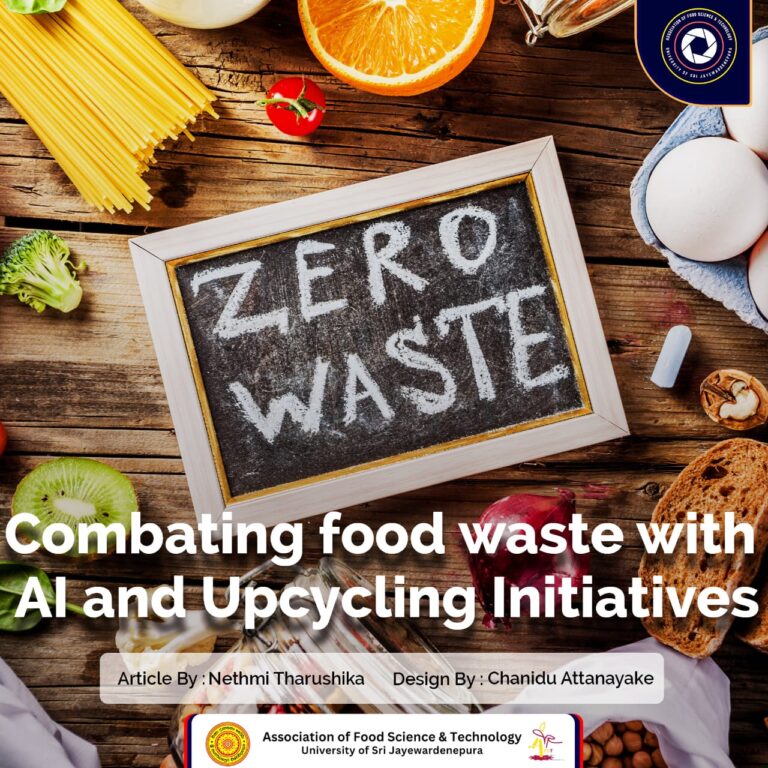
Introduction
Food waste is one of the most pressing issues, as it not only contributes to higher emission levels but also causes significant environmental damage, often more severe than many other issues. Food waste is responsible for 8 to 10% of global greenhouse gas emissions, according to the United Nations Environment Programme (UNEP). From an environmental sustainability standpoint, reducing food waste is a no-brainer, but it also plays into the broader United Nations Sustainable Development Goals (SDGs), specifically SDG 12.3: By 2030 to halve per capita global food waste. Recently, upcycling initiatives and Artificial Intelligence (AI) have become novel solutions corresponding to this widespread issue. In the food industry, AI technology is used to plan optimal food supply chains; predict demand, and prevent waste in different directions of the food production-denial-logistic process. At the same time, upcycling technologies are also turning soon-to-be wasted food into high-value products that both reduce waste and add to a circular economy.
Artificial Intelligence (AI) for Food Waste Reduction
When considering food waste solutions, AI plays a crucial role in how we approach food management. AI can predict consumer demand more accurately and assist retailers and manufacturers in aligning their inventories effectively, thereby reducing waste. This is achieved through advanced data analytics and efficient machine-learning algorithms. In another case in point, AI-based tools are employed to extend the shelf life of perishable products which ought to be sold out before they pass the expiry date. The efficiency of food distribution networks is also going up with the help of AI, not just in predictive analytics. Machine Learning can measure the distribution of goods (e.g., where are bottlenecks or in which location food is most likely to spoil), by analyzing large volumes of data. It improves logistical planning and helps ensure that food moves from farms to tables efficiently, minimizing waste Additionally, AI is helping to monitor and reduce food waste at a large scale in universities or hospitals. AI-enabled smart kitchen systems can track waste in real-time, which is an example of how technology could provide data insights on where the waste comes from and/or advice to remove it.
Upcycling Initiatives: Turning Waste into Opportunity
Upcycling is the process of converting by-products, waste materials, and useless products into new materials or better-quality products that can be used in environmental objects. This approach helps prevent food waste and promotes more efficient use of resources. Additionally, it provides opportunities for artisans to grow economically by entering competitions with their products. The Upcycled Food Association (UFA) has spearheaded the promotion of upcycling as a food waste solution. In trying to devise solutions, their work has helped establish several upcycled food products including snacks derived from spent grains and beverages made using fruit peels. Not only can these items cater specifically to environmentally conscious consumers, but they also physically offer a solution for wasted food. By upcycling food waste, an action that the U.S. Environmental Protection Agency (EPA) says reduces methane emissions caused by landfilling organic waste while improving overall environmental impacts in terms of food production. In addition to the relief of pressure on landfills, upcycling initiatives are also playing a role in decreasing greenhouse gas emissions an important aspect of mitigating climate change as well.
The AI and Upcycling Synergy
The evolution of upcycling initiatives to include AI may be a significant factor in reducing food waste. By pinpointing possible food waste streams and proposing new ways to address them, AI can help streamline the upcycling process. For instance, platforms with AI-driving capabilities can link producers of food and upcycling companies to effectively reuse surplus foods that would otherwise end up in the trash. The role of AI can also be to increase the scalability of such operations by automation and reducing costs, as well as their traceability to upcycled-related products. This is important not just for the financial relevance of upcycling, but also that it guarantees to attain as much environmental benefit as possible.
Conclusion
The potential of AI coupled with upcycling campaigns opens an innovative pathway towards the global struggle against food wastage. Such novelties, dealing with environmental sustainability, economic growth, and global development goals, are brought about by smoothing food supply chains and turning waste into resources through state-of-the-art technologies. At scale, building and deploying such solutions helps to cement a future without a massive amount of food wastage and with it, associated large environmental and economic benefits.
Written by:R.A Nethmi Tharushika (1st year)
References
UN Environment Programme (2021). Food Waste Index Report 2021. Available at: https://www.unep.org/…/unep-food-waste-index-report-2021 (Accessed: 08 August 2024)
UN Environment Programme (2024). Food Waste Index Report 2024. Available at: https://www.unep.org/…/pub…/food-waste-index-report-2024 (Accessed: 08 August 2024)
United States Environmental Protection Agency (2022). Food Waste Research. Available at: https://www.epa.gov/land-research/food-waste-research (Accessed: 08 August 2024)
Upcycled Food Association (n.d.). Growing the Upcycled Food Economy: Building a food system where all food reaches its highest and best use. Available at: https://www.upcycledfood.org/ (Accessed: 08 August 2024)
